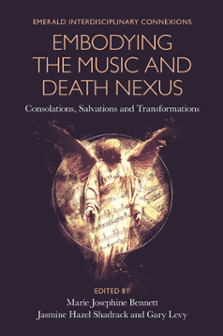
Death and the Canon: Classical Entanglements of Death, Grief and Perspective
Embodying the Music and Death Nexus
ISBN: 978-1-80117-767-2, eISBN: 978-1-80117-766-5
Publication date: 17 August 2022
Citation
(2022), "Death and the Canon: Classical Entanglements of Death, Grief and Perspective", Bennett, M.J., Shadrack, J.H. and Levy, G. (Ed.) Embodying the Music and Death Nexus (Emerald Interdisciplinary Connexions), Emerald Publishing Limited, Leeds, pp. 1-1. https://doi.org/10.1108/978-1-80117-766-520221013
Publisher
:Emerald Publishing Limited
Copyright © 2022 Marie Josephine Bennett, Jasmine Hazel Shadrack and Gary Levy. Published under exclusive licence by Emerald Publishing Limited
The essays in the first section of the collection focus on composers whose pieces fall under the umbrella of ‘classical’ music, namely Johann Sebastian Bach (1685–1750), Wolfgang Amadeus Mozart (1756–1791) and Gustav Mahler (1860–1911). Death was a constant companion during their compositional lifetimes. For example, all three composers had children who died in infancy and/or early childhood. In the first chapter, ‘Permeating the membrane: Death as life-fulfilment through the prism of Bach's Ich habe genug (BWV 82)’, Gary Levy examines the peaceful acceptance of death offered via the composer's setting of the anonymous text to music. He also deliberates on the reasons for the continuing popularity of this oft-recorded cantata. In the second chapter, ‘Mozart's Music in Film: Death and Embodied Affect’, Marie Josephine Bennett considers how specific works by Mozart are employed in three different movies to highlight the music and death nexus present in each filmic narrative. As she argues, in each of the films analysed, a piece of music by the composer is connected to death and embodied affect. In the final chapter of this section, ‘Mahler's Second Symphony: Intuitively Embodying Grief and Dying’, Benjamin Lassauzet proposes that Mahler instinctively demonstrated the 5-stage model of approaching death illustrated by Elisabeth Kübler-Ross in 1969 within his Symphony No. 2, first performed in 1895. As Lassauzet suggests, in some ways, one could claim that the grief model was conceived via Mahler's composition, rather than through the text of Kübler-Ross.
- Prelims
- Section 1 Death and the Canon: Classical Entanglements of Death, Grief and Perspective
- Chapter 1 Permeating the Membrane: Death as Life-Fulfilment Through the Prism of Bach's Ich habe genug (BWV 82)
- Chapter 2 Mozart's Music in Film: Death and Embodied Affect
- Chapter 3 Mahler's Second Symphony: Intuitively Embodying Grief and Dying
- Section 2 Chthonics: Travelling Through Death on Black Metal's Wings
- Chapter 4 Death as Negation: Black Metal's Disturbing Apophatic Insight
- Chapter 5 ‘I Saw the End’: An Autoethnographic Exploration of Music, Cancer Treatment and Death
- Chapter 6 Abyssal Noise: Representations of Death and Dying in Extreme Metal Music
- Section 3 Death and Resurrection: Marginalised Voices
- Chapter 7 Naked History: A Musical Embodiment
- Chapter 8 Death and a Life: Renihilative Metamorphosis
- Chapter 9 Regulation, Resistance and Resurrection
- Section 4 Life Beyond Death: Mourning, Mythology and the Sound of Loss
- Chapter 10 Sounding the Architecture of Grief: Requiem, Rhetoric and Embodied Experience
- Chapter 11 Experiencing the Sound of Loss: Music and Bereavement Theory
- Chapter 12 Between a Man and a Myth: The Death of John Fitzgerald Kennedy and Popular Music
- Epilogue
- Index